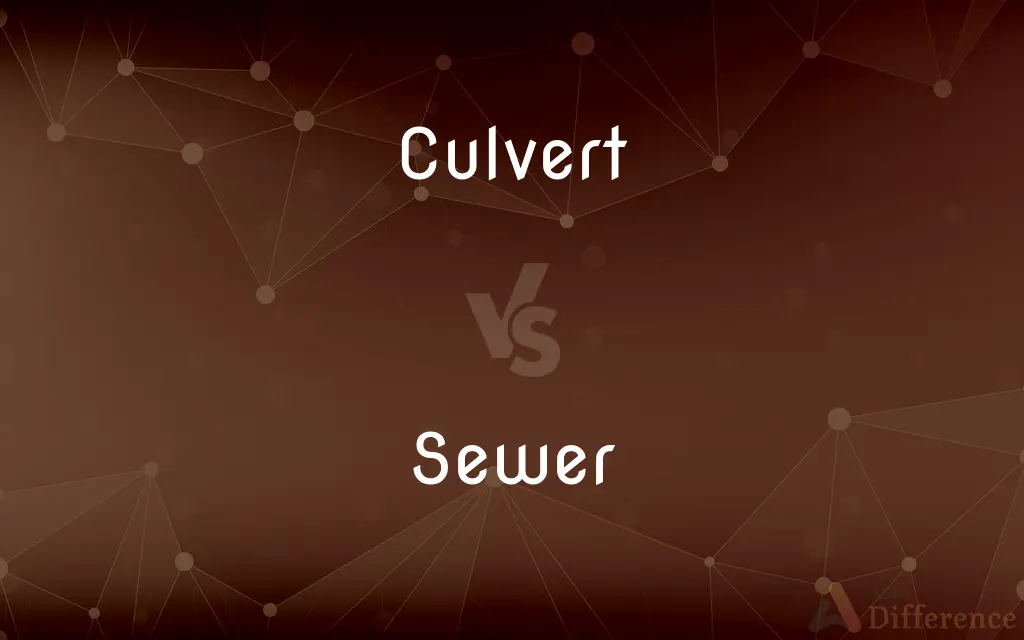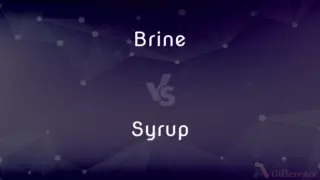Culvert vs. Sewer — What's the Difference?
By Maham Liaqat & Fiza Rafique — Updated on May 1, 2024
Culverts channel water under roads to prevent flooding, focusing on drainage; sewers transport wastewater from buildings, emphasizing sanitation.

Difference Between Culvert and Sewer
Table of Contents
ADVERTISEMENT
Key Differences
Culverts are typically designed to channel water from natural sources like streams or excess rainwater under transportation structures like roads or railways, enhancing drainage and preventing road overtopping. Whereas sewers are fundamentally designed to transport wastewater and sewage from residential, commercial, and industrial sources to treatment facilities.
A culvert can be made from materials such as metal, concrete, or plastic and is shaped to fit the natural contours of the landscape to ensure efficient water passage. On the other hand, sewers are primarily constructed from materials that ensure durability and corrosion resistance, such as PVC, concrete, or vitrified clay, due to the aggressive nature of sewage.
The installation of culverts is usually part of broader road construction or landscaping projects, aimed at managing surface water and preventing erosion. Conversely, sewers are installed as part of municipal infrastructure projects focused on public health and environmental protection by managing waste.
Maintenance of culverts involves clearing debris and ensuring the integrity of their structure to prevent blockages and flooding. Sewers, however, require more complex maintenance including flushing, repair of leaks, and prevention of blockages from non-biodegradable materials.
Regulatory oversight for culverts typically falls under local or state environmental and transportation departments, emphasizing their role in water management and road safety. Sewers, however, are regulated by environmental and public health authorities, highlighting their critical role in sanitation and community health.
ADVERTISEMENT
Comparison Chart
Primary Purpose
To channel water under roads or railways
To transport wastewater to treatment plants
Common Materials
Concrete, metal, plastic
PVC, concrete, vitrified clay
Installation Context
Part of road construction or landscaping
Part of urban infrastructure projects
Maintenance Focus
Clearing debris, structural integrity
Flushing, leak repair, blockage prevention
Regulatory Oversight
Environmental and transportation agencies
Environmental and public health authorities
Compare with Definitions
Culvert
Often made from concrete or metal.
The metal culvert was chosen for its quick installation and cost-effectiveness.
Sewer
May require technology for treatment processes.
The new sewer section includes advanced sensors for leak detection.
Culvert
Can be affected by blockages from debris.
The culvert was cleaned to remove the accumulated leaves and branches.
Sewer
Managed by municipal water authorities.
The water authority conducts annual inspections of the sewer infrastructure.
Culvert
A tunnel structure under roads for water passage.
The new road design includes a culvert to prevent spring flood damage.
Sewer
A pipeline system for carrying sewage.
The city plans to expand the sewer system to accommodate new residential areas.
Culvert
Engineered to prevent roadway erosion.
They installed a culvert at the bend to enhance water flow control.
Sewer
Essential for urban sanitation.
Regular maintenance of the sewer lines ensures a hygienic city environment.
Culvert
Integral to flood management systems.
Culverts are critical components in the town's flood mitigation strategy.
Sewer
Vulnerable to blockages from improper waste disposal.
Public campaigns aim to reduce the dumping of fats in the sewer.
Culvert
A culvert is a structure that allows water to flow under a road, railroad, trail, or similar obstruction from one side to the other. Typically embedded so as to be surrounded by soil, a culvert may be made from a pipe, reinforced concrete or other material.
Sewer
An artificial, usually underground conduit for carrying off sewage or rainwater.
Culvert
A tunnel carrying a stream or open drain under a road or railway.
Sewer
A medieval servant who supervised the serving of meals.
Culvert
Channel (a stream or drain) through a culvert
A culverted drain
We have asked for the river to be culverted
Sewer
One that sews
A sewer of fine clothing.
Culvert
A sewer or drain crossing under a road or embankment.
Sewer
A pipe or system of pipes used to remove human waste and to provide drainage.
Culvert
The part of a road or embankment that passes over such a sewer or drain.
Sewer
A servant attending at a meal who is responsible for seating arrangements, serving dishes, etc.
Culvert
The channel or conduit for such a sewer or drain.
Sewer
One who sews.
Culvert
A channel crossing under a road or railway for the draining of water.
Sewer
A small tortricid moth, the larva of which sews together the edges of a leaf using silk.
Culvert
To channel (a stream of water) through a culvert.
Sewer
(transitive) To provide (a place) with a system of sewers.
Culvert
A transverse drain or waterway of masonry under a road, railroad, canal, etc.; a small bridge.
Sewer
One who sews, or stitches.
Culvert
A transverse and totally enclosed drain under a road or railway
Sewer
A small tortricid moth whose larva sews together the edges of a leaf by means of silk; as, the apple-leaf sewer (Phoxopteris nubeculana)
Sewer
A drain or passage to carry off water and filth under ground; a subterraneous channel, particularly in cities.
Sewer
Formerly, an upper servant, or household officer, who set on and removed the dishes at a feast, and who also brought water for the hands of the guests.
Then the sewerPoured water from a great and golden ewer,That from their hands to a silver caldron ran.
Sewer
A waste pipe that carries away sewage or surface water
Sewer
Someone who sews;
A sewer of fine gowns
Sewer
Misfortune resulting in lost effort or money;
His career was in the gutter
All that work went down the sewer
Pensions are in the toilet
Common Curiosities
What typical problems can affect culverts?
Common issues include blockages from debris, structural damage from heavy traffic, and erosion around the inlet and outlet.
How do culvert sizes get determined?
Culvert sizes are determined based on expected water flow rates, the area's topography, and hydrological data to prevent overflow and optimize drainage.
What innovations are being implemented in sewer design?
Innovations include smart sewer technology with sensors for real-time monitoring, and designs that reduce energy use and improve efficiency in waste treatment.
Can culverts affect local wildlife?
Yes, if not properly designed, culverts can obstruct the natural movement of aquatic and terrestrial wildlife, impacting local ecosystems.
How often should sewers be inspected and maintained?
Sewers should be inspected at least annually, with more frequent checks in areas prone to blockages or with older infrastructure.
How do sewers impact the environment?
Properly managed sewers reduce environmental pollution by safely transporting and treating wastewater, but leaks or overflows can contaminate water bodies and soil.
What are the health risks associated with damaged sewers?
Damaged sewers can lead to sewage leaks or overflows, which pose serious health risks like waterborne diseases and unpleasant odors.
Are there alternative materials used for culverts besides concrete and metal?
Yes, plastic and fiberglass are also used for culverts, especially in corrosive environments or where lightweight materials are advantageous.
How are culverts designed to accommodate environmental concerns?
Environmental-friendly culvert designs include features like fish ladders or open-bottom designs to facilitate wildlife passage and reduce ecological disruption.
What types of pollutants are most concerning in sewer systems?
Concerns include chemical contaminants, pharmaceutical residues, heavy metals, and non-biodegradable materials like plastics.
What are the consequences of not maintaining culverts properly?
Neglected culverts can lead to road collapses, increased flooding risk, and significant repair costs.
What is the average lifespan of a sewer system?
The lifespan of sewer systems can vary widely but typically ranges from 50 to 100 years, depending on materials and maintenance.
What role do sewers play in flood management?
Sewers help manage urban flooding by removing excess stormwater from streets, although they can become overwhelmed during heavy rainfall.
How do community practices influence sewer efficiency?
Community habits, such as disposing of grease or non-flushable items in drains, can greatly impact sewer efficiency and require more frequent maintenance and repairs.
Can culverts be used for purposes other than water management?
Occasionally, culverts are also used for small animal crossings under roads or as conduits for cables and utilities.
Share Your Discovery

Previous Comparison
Brine vs. Syrup
Next Comparison
Thermocouple vs. ThermostatAuthor Spotlight
Written by
Maham LiaqatCo-written by
Fiza RafiqueFiza Rafique is a skilled content writer at AskDifference.com, where she meticulously refines and enhances written pieces. Drawing from her vast editorial expertise, Fiza ensures clarity, accuracy, and precision in every article. Passionate about language, she continually seeks to elevate the quality of content for readers worldwide.
















































